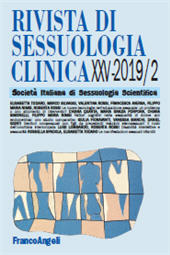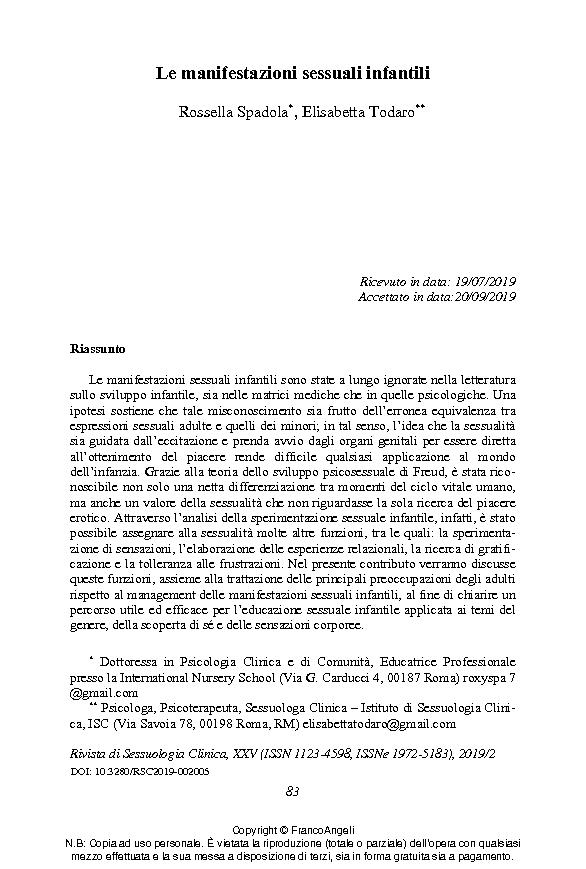Le manifestazioni sessuali infantili
83-105 p.
Le manifestazioni sessuali infantili sono state a lungo ignorate nella letteratura sullo sviluppo infantile, sia nelle matrici mediche che in quelle psicologiche. Una ipotesi sostiene che tale misconoscimento sia frutto dell'erronea equivalenza tra espressioni sessuali adulte e quelli dei minori; in tal senso, l'idea che la sessualità sia guidata dall'eccitazione e prenda avvio dagli organi genitali per essere diretta all'ottenimento del piacere rende difficile qualsiasi applicazione al mondo dell'infanzia. Grazie alla teoria dello sviluppo psicosessuale di Freud, è stata riconoscibile non solo una netta differenziazione tra momenti del ciclo vitale umano, ma anche un valore della sessualità che non riguardasse la sola ricerca del piacere erotico.
Attraverso l'analisi della sperimentazione sessuale infantile, infatti, è stato possibile assegnare alla sessualità molte altre funzioni, tra le quali: la sperimentazione di sensazioni, l'elaborazione delle esperienze relazionali, la ricerca di gratificazione e la tolleranza alle frustrazioni. Nel presente contributo verranno discusse queste funzioni, assieme alla trattazione delle principali preoccupazioni degli adulti rispetto al management delle manifestazioni sessuali infantili, al fine di chiarire un percorso utile ed efficace per l'educazione sessuale infantile applicata ai temi del genere, della scoperta di sé e delle sensazioni corporee. [Testo dell'editore].
Sexual expression in children has been ignored for a long time within the literature, both in medical and psychological fields. A hypothesis suggests a wrong equivalence between adult and infant sexual expressions; in this sense, the idea that sexuality is guided by excitement and starts from the genital area to achieve pleasure make difficult any application to childhood. Referring to infantile sexuality, it is important to understand that we are not talking about a genital sexuality, but a pregenital once, which is completely different from the first. The pregenital sexuality manifestations are connected to specific areas and functions of the body, or relational functions too. The child experiences the pleasure (or displeasure), coming from the contact of the body, in his significant relationships with the adult, as a result of being nourished, cleaned, washed, carried, kissed, caressed, swayed, cuddled, admired and involved.
Thanks to all these experiences, the child learns that through the body it is possible to "manage" or "store" some experiences. Therefore, through the body, the child will look for a strategy to overcome or make his own emotions, such as boredom, euphoria, anger and sadness. Thanks to Freud's psychosexual development theory, it was recognized a clear differentiation between childhood and adulthood. Moreover, sexuality that does not concern only the search for erotic pleasure. In fact, through the analysis of infantile sexual experience, it was possible to assign many other functions to sexuality, including feeling sensations, the elaboration of relational experiences, the search for gratification and the tolerance to frustration. In continuity with the European Standards for Sexual Education, it is presented an approach in which sex education begins at birth. Children begin the process of learning their sexuality as soon as they are born.
Master and Johnson have shown, like many other scholars, that it is possible to detect a genital response already during fetal life through ultrasound. At the birth, parents begin, implicitly and explicitly, to transmit to the children messages concerning the body, the intimacy, the relationship and the integration between experiences and perception. While, on the one hand, children need love and support to form their own sexual identity, on the other they need to acquire knowledge and skills, for which formal education programs play an important role. Sex education supports the child's sensory development, the perception of his own body and a positive body image; at the same time, it strengthens selfconfidence and contributes to developing the capacity for selfdetermination. The child acquires the ability to behave responsibly towards himself and others; learns that there are social norms to be respected and to recognize. In this way, therefore, sex education is also education in social and relational
The present work discuss all these functions, together with the possible management of infantile sexual manifestations, in order to clarify a useful and effective path for infantile sex education applied to gender issues, selfdiscovery and body sensations. It is clear that it can be very difficult for parents to manage some particular behaviors observed in their children regarding sexual stimulations, because of different emotional and cultural aspects. At the same time, teachers can often observe these behaviors without having a clear idea of what and how to do. This lack of definition can be linked and explained to many reasons, discussed in the present work. In general, in these cases it is important to assume an holistic vision for sex education, which provides impartial information on all aspects (physical, affective, social, cultural).
The central prerequisite for sex education is that it has its space at school and is included in the curriculum programs; moreover, it should be implemented in an interactive way, taking into account the experiences and needs of the children and adolescents included. [Publisher's text].
Fa parte di
Rivista di sessuologia clinica : 2, 2019-
Articoli dello stesso fascicolo (disponibili singolarmente)
-
Informazioni
Codice DOI: 10.3280/RSC2019-002005
ISSN: 1972-5183
MATERIE
PAROLE CHIAVE
- Sviluppo psicosessuale, educazione sessuale, corpo, identità di ge-nere, promozione, salute sessuale
- Sexual development, sexual education, body, gender identity, promotion, sexual health



